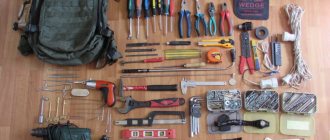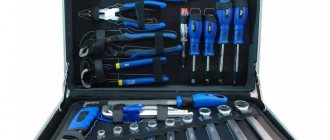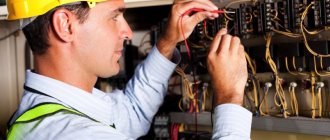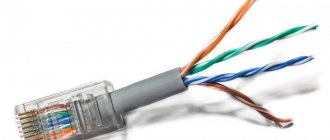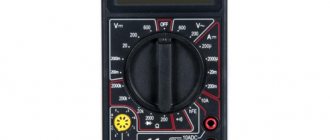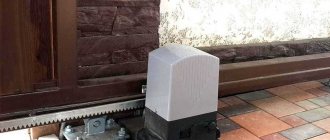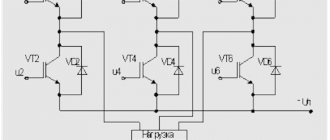- home
- How to choose the best electrician tool kit?
The choice of a set of tools depends on the tasks ahead and the user’s personal preferences. What should you pay attention to when choosing “your” set? Is it worth purchasing a ready-made set or is it better to assemble an individual one from separate tools? On this matter, we bring to your attention the expert opinion of the leading tool specialist at IMAG, Vladislav Koltsov.
What is the best tool kit for an electrician? Let's look at this issue in detail. I had to work with tools from different manufacturers and in different price categories, I read a lot, searched, compared, but didn’t settle on anything specific. There are many decent pliers, side cutters, screwdrivers, etc., but even more outright junk. To choose just the right electrician's kit, you need to include a little philosophy.
“The best” is what brings us pleasure, the joy of owning and using it, and the pride of having it. This can be said about everything and tool sets are no exception. For ourselves, for our home, we often buy high-quality and expensive tools, even if we don’t know when they will come in handy. At first glance, this is a little strange, because for rare works, any would be suitable. It is difficult to describe in words the inner feeling and reasons why the hand reaches out to the good, even when it is excessive for simple tasks. Probably, this is the desire to be confident in the tool, the understanding that the “helper” is reliable and can be relied on even after many years.
If you are a professional installer, then the answer is clear - buy a good one. The presence of a specialized tool from a master is a big plus, distinguishing a professional from handymen offering their services. As they say, you meet someone by their clothes. The customer is more willing to part with money when he sees the high level of equipment and qualifications of the electrician. Don't ignore this fact.
Modern sets of tools for electrical installation are so different that it is difficult to settle on something. On the one hand, I don’t want to pay for something I don’t need; on the other hand, I’m not sure what might be useful in the future. In any case, every electrician needs side cutters (nippers), pliers, long-nose pliers, an insulation stripper (stripper), and a set of dielectric screwdrivers. And it’s better that all this is conveniently and compactly folded into something for quick access and easy transportation.
Tool types
An electrician's tools can be divided into main and auxiliary.
Also, tools can be divided by type of use: electrical - the electrician uses them to check networks, connect wires, install electrical devices, and installation - with the help of which the electrical network is laid and installed.
An electrician does not have many electrical tools and partings, but they should always be at hand.
Often, for this, electricians use special belts with pockets for tools.
This kit includes:
- Knives;
- Screwdriver Set;
- Pliers, pliers, wire cutters, stripper;
- Measuring instruments (multimeter, current clamp);
- Insulating materials.
When laying networks, as well as installing electrical equipment, in addition to the specified tools, an electrician may additionally need:
- Hammer with attachments (drills, crowns);
- Screwdriver;
- Wall chaser;
- Press key;
- Hammer;
- Electrical level, tape measure;
- Set of open-end and spanner wrenches;
- Tools for specific work conditions.
And these are just the tools and equipment that an electrician may need, but there are also consumables.
But for now we are only interested in tools and devices, as well as what they do.
Electrician tool kits - convenience or excess?
So, we have learned what every electrician needs to have, now it’s worth answering another question - is it worth buying specialized kits? Of course yes! However, it all depends on your needs.
- CNC milling: features
Voltage indicator - what types of testers are there and how to use them correctly? Operating instructions and 110 photos of different models
Phase meter - principle of operation, design, connection, care and repair of the device
For minor household troubles, such as an outlet failure, a small set is suitable, including screwdrivers, pliers, pliers, insulating materials and a multimeter.
In the kits designed for electrical installation work, you can find a screwdriver, a set of keys, strippers, a tape measure, various types of screwdrivers, a hammer, etc.
All the tools an electrician needs can be easily taken out of a plastic case or briefcase and are always at hand, which is very convenient.
Knives
So, a good electrician has several types of knives in his belt pockets. The first is a regular folding knife. It is used for various purposes - trimming, stripping, etc.
The main one is an electrical knife with a special blade shape.
In addition to its shape, its blade is sharpened on both sides, which allows you to strip wires in two directions - toward you and away from you.
Some types of electrical knives have a special heel at the end of the blade.
This knife allows you to cut the lumbar insulation of the wire without possible damage to the internal insulation of the wires.
The third type of knife that an electrician may have is a regular construction knife with replaceable blades. It can be used like a regular folding knife.
Screwdrivers
One of the main tools of an electrician is a screwdriver. Every specialist has several types of screwdrivers, but they are all specialized electrical ones.
Their peculiarity lies in improved protection. Typically, such screwdrivers have a tip covered with a non-conductive material on top; only the tip of the screwdriver is exposed.
A Phillips and flat head screwdriver is required. The best option is to have several screwdrivers with different sizes.
Electricians also use indicator screwdrivers, which, in addition to the ability to tighten and unscrew bolts, also allow you to check the presence of voltage in the wiring before starting work.
A simple indicator screwdriver is equipped with a diode light. When you touch the wire with the tip of a screwdriver, if there is voltage in it, the light bulb will light up.
Indicator screwdrivers with a display are more complex. In addition to detecting the presence of voltage in the wires, this screwdriver also displays the voltage voltage.
Also read here about battery-powered screwdrivers, which can also be used for electrical work.
A good example of the minimum required tool, insulated to 1000V:
Jonard TK-110INS - insulated tool set up to 1000 V (11 pieces in a case)
Jonard TK-110INS set
Consists of pliers and screwdrivers made of good chrome vanadium steel 60 CRV, it is reliable and durable. The cutting edges are high frequency induction hardened for superior toughness. The handles are made of two-color thermoplastic elastomer (TEP). The tools are tested to 10,000 VAC and can be used on lines up to 1000 VAC. Complies with international standards IEC 60900. The tool is housed in a convenient book case made of very durable nylon.
To fully work with live parts, you will additionally need: an electrician's knife, a tester screwdriver, a multimeter for measuring voltage, a signal generator and a probe antenna for selecting the desired cable from a bundle and tracing it in the wall, adjustable pliers, a rubber mat, dielectric gloves and safety glasses . This list can be continued for a long time. In the process of work, everyone will understand what else may be needed. There are never too many tools, just not enough space ☺.
Pliers, pliers, etc.
Pliers, pliers and wire cutters are also one of the most important tools for an electrician.
Pliers and pliers allow you to twist wires, make the desired bend in the wire, hold it while making connections, etc.
Often, the jaws of the pliers have sharpened blades for cutting the wire, but few people use them, since the quality of cutting the cable with the pliers is low, and the edge of the wire turns out to be somewhat compressed.
It is better to use wire cutters to cut the wire. Their blades have a specific shape, which allows you to make a high-quality cut without compressing the edges of the cable.
A stripper is a special tool that allows you to quickly and efficiently remove insulation from wires, without damaging the wiring cores.
Its use makes it possible to carry out installation work much faster.
An example of a more “rich” set of tools for electricians
SK-16 B1 - insulated tool set in a bag 17 items
SK-16 B1
– a set of professional electrician’s tools insulated up to 1000 V in a convenient durable bag. The tool is forged and heat treated from high-strength steel and has two-component insulated handles. Complies with EN60900, IEC/CEI900, VDE0686 standards. This set additionally contains an insulated knife, a special electrician's knife with a stripper for stripping insulation from wires of different diameters, and angled long-nose pliers. There are selections of dielectric tools that some can only dream of, but everyone would definitely like to get their hands on. These are kits for all occasions for an electrician from German and American manufacturers: Klauke, Jensen, Knipex, Haupa, Wiha. Below are two such sets.
Measuring instruments
The presence of measuring instruments is also important. The advent of multimeters made life much easier for electricians.
It is enough to have only this device to make all the necessary measurements.
But all the measurements can be performed only by connecting a multimeter to the stripped wires, which is not always convenient.
Current clamps allow you to measure the current without the need to break the wiring for connection.
It is enough to place the wire in the pliers for this device to show the current strength. Based on this, it turns out that an electrician needs both of these devices.
There are also combined instruments that include both a multimeter and a current clamp.
Insulation materials
The presence of insulating materials is mandatory. Electricians use two types of such material - electrical tape and heat shrink.
Both of these types allow you to insulate the connection points to prevent a person from touching exposed live wires.
Insulating tapes can be made of fabric (cotton, lavsan), impregnated with a special insulating glue, or polyethylene, with an adhesive surface.
Heat shrinks are tubes made of insulating material of different diameters, which, when exposed to high temperatures, shrink and adhere to the joint surface.
Tools required for installation work
Let's move on to the tool that an electrician will need for laying and installing electrical circuits.
So, a hammer drill with drills allows you to make holes in the walls of a building for pulling wires.
The same device, but with crowns, makes recesses in the walls for installing sockets, switches, and junction boxes.
A screwdriver will be needed to quickly tighten all kinds of screws during installation work, for example, to secure tunnels into which wiring will be laid. Also, when working at a distance from the industrial network source, it is convenient to use special battery-powered tools.
Using a wall chaser, small recesses are made in the walls for laying wiring in them - grooves.
Without this device, an electrician will have to make grooves either with a hammer drill or an angle grinder with a diamond wheel, which is very inconvenient and labor-intensive.
A press wrench is used by electricians to compress special copper caps on wire strands. The use of this key allows you to strengthen the connection of twisted wires.
A hammer is a universal tool that is needed not only by electricians. And when installing the wiring, he will have enough work.
An electrician may need open-end wrenches when performing industrial installation work.
For some electrical devices that operate with high power parameters, the wiring to them is secured using bolted connections, which is why keys are needed.
Measuring instruments such as a tape measure and a level are mostly needed for preparatory work.
The tape measure is used for correct measurements when punching grooves, measuring the length of wiring, etc. A level will be needed to secure sockets and switches evenly.
Also, during installation, an electrician may need a wide variety of tools.
For example, the internal partitions of a building are made of wood, then to make holes you will need a drill with different drills, and for grooves - chisels.
In some cases, reciprocating saws may come in handy.
Choosing the right tools
How to choose a tool for an electrician? It all depends on the needs of a particular person. To replace a light bulb, you only need your hands, but to identify a fault in the wiring, you need a whole series of devices. For small housework, the 6 items described above are enough, but if we are talking about professional activities, everything is much more complicated.
There are two types of electrician tools: basic and auxiliary. In addition, according to the type of work they are divided into electrical and installation - some are needed when checking networks, connecting wires and installing devices, others, for example, for laying wiring.
Knives
In many cases, an electrician needs two types of knives: one regular, auxiliary, the other special, electrical - they are more convenient for removing insulation without the risk of damaging the wire itself.
Screwdrivers
The work uses not only ordinary screwdrivers, but also specialized electrical ones. Some are covered with insulating material, have sensors to check the phase and allow other useful properties.
Having a Phillips and flat head screwdriver is a must, but it is also necessary to have a universal tool with different bits.
Screwdrivers that display voltage voltage are very useful. They usually can withstand up to 500v, which is quite acceptable.
Pliers and pliers
Pliers or pliers are often placed in an electrician's toolbox, with which it is convenient to work with wires: twist, bend or hold in the position required for connection.
Note that for cutting wires, wire cutters are better suited than pliers - the blades of the latter are usually poorly sharpened and pinch the corner of the cable, which is not good.
It is easier and faster to remove insulation from a cable with a special stripper rather than with a knife. However, the lack of this tool should not be a problem for an experienced craftsman.
Measuring instruments: testers and multimeters
A multimeter is a very important instrument for an electrician. It can be used to measure voltage, conductor resistance, and much more, which greatly simplifies the work.
If the wires for measurement cannot be stripped, current clamps are used: the cable is clamped with the tips of the device, and information about the current strength is displayed on the screen. For convenience, there are combined devices on the market of the pliers + multimeter type.
Insulating tapes and heat shrinks
In the photo of electrician's tools, if we talk about sets, we always see insulating materials - without them, working with wires through which current passes is almost impossible.
The insulation of the wire connections is carried out either using a special tape or heat shrink - a tube that contains material inside that adheres to the surface of the cable when heated.
- How to properly connect a duct fan
- Details about TML tips
In which industries is a soldering iron used?
Tools for electrical work
To install wiring indoors, you need a hammer drill with a special attachment to make holes in the walls. It is also convenient for them to prepare places for sockets, switches, etc.
It is much easier to tighten screws with a battery-powered screwdriver - this way the technician will not be tied to the general network of the building, which means he will be able to work in conditions where there is no electricity.
Laying wiring without using a wall chaser is very problematic - with this power tool, a specialist makes small recesses in the walls, where cables will later be laid.
Hammer, tape measure and personal protective equipment
A hammer is a truly universal tool for an electrician, which will come in handy at all stages of electrical work. The same applies to a measuring tape - without it, you won’t even be able to find out the length of the cable (if there are no special markings on it).
Strong glasses, rubber boots and gloves, as well as a special uniform - without which it is extremely dangerous to carry out some types of work. It is very important to protect yourself from possible contact with exposed wire.
